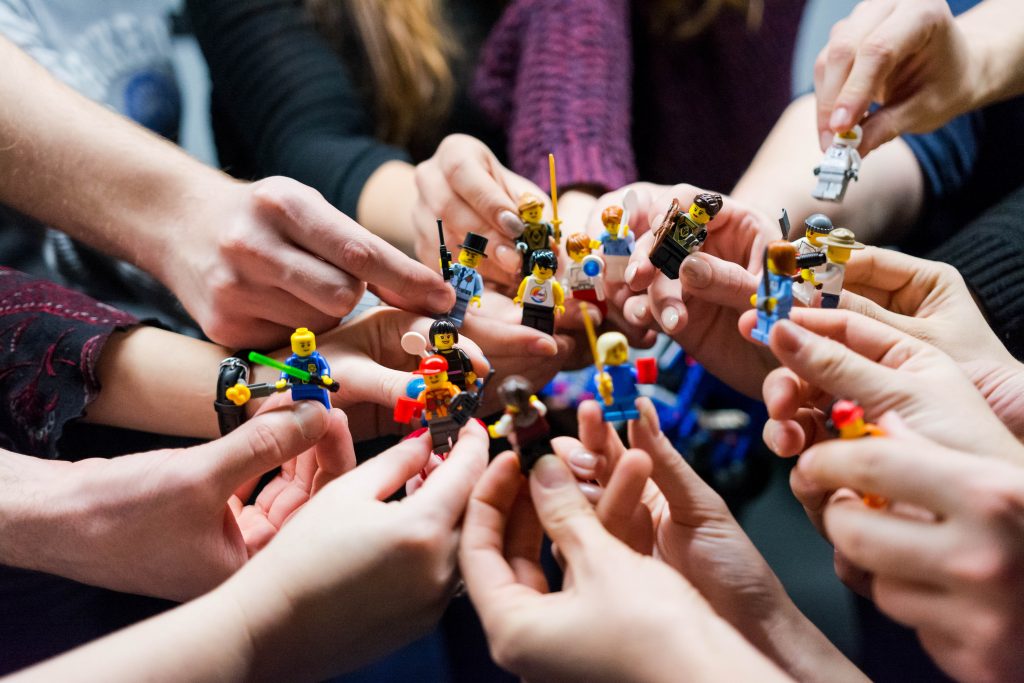In any setting where people have been working together in a project or an organization, there is the need, every now and then, to disengage from work with content and focus on interpersonal relationships. This is a very fancy way to say: people should have fun at work every now and again – why not with some team building games?
The perfect opportunities for these short intersects are regular team meetings, or even team events where you can use the following games to facilitate team building and team activation. These work best, if the people already know each other, i.e. in the regular organizational setting or after they have done some icebreaker games.
The activities you find here are usually best performed in an offline, in-person setting, as this provides the needed interactions for building up team structures and activating the team. If you need more fun games, check out our team evening games, and if you want to (or need to…) get the creative juices flowing for people who haven’t worked together before, check out our icebreaker games.

Tower of Pisa
For this classic team building game, you divide the participants into groups of four to five people, easiest of course with our teamshufflr app. Each group gets 20 individual spaghettis, a roll of scotch tape, about one meter of string and one regular sized marshmallow.
The team that builds the tallest structure out of these components within the set time frame of 15 minutes wins. The only condition is that the structure needs to be free standing and hold up for at least one minute after the challenge is finished – so you better get to measure fast!
To make the game a little more interesting, you can also introduce a scoring system, in which the height is counted with three points, the stability is counted with two points (measure this by moving the table the tower was built on), and the design with two points (extravagant designs are rated higher – this is a highly subjective matter). This way, there will be more varying outcomes in shape and form.
Floating Stick
This really fascinating activation game only requires one prop: a broomstick or any similar rigid structure. Have the whole team gather around the broomstick – if there are too many people, divide the team into two groups. Every participant now needs to hold one index finger out and adjust the position so that the index finger touches the floating stick.
The goal of this exercise is to lower the stick to the ground without any of the participants ever losing touch with the floating stick. Watch and see the fascinating floating capabilities of this almost magical stick!
Agile Ball Game
The Agile Ball Game is an activation activity that also allows the team to see how agile methods enhance processes and lead to better results over time. For this activation game you’ll need to have some time (30 to 60 Minutes) and some props:
- balls, about one per participant and best in the size of a tennis ball
- stopwatch (i.e. smartphone for most anyone living in the 21st century – if you come to us from another time, let us know, we’re interested! But I digress…)
- flipchart
You can divide the participants up into groups of at least seven players, but more players are always possible.The rules for this ball game are as follows:
The goal is to get as many completed run throughs as possible. To count as a run through, each ball must have air-time and be touched at least once by every team member to count. Balls can’t be passed to your direct neighbor to your immediate left or right. Each ball must return to the same person who introduced it into the system. And each ball that is dropped counts as a defect.
There are rounds of about two minutes each, in which the operations are working, i.e. where balls are flying and run throughs are made. Before each round – or iteration in agile speech – each team has about two minutes to get the process of handing the balls to each other right/adjusted and then needs to estimate how many successful run throughs they can manage in the upcoming round of two minutes.
Then rinse and repeat, for up to five rounds the teams can adjust the process and become faster each round, hopefully. At the end everyone can see on the flip chart that adjusting the process leads to a much improved process and higher output without needing more resources from the team. At the end, there is a short retrospective period, where you allow the team to reflect upon the method, what went wrong, what went well etc.
To make this team building game more interesting, you as the moderator can come in and create a little more stress in the environment by dropping lines such as: “The last time I played this game, the team had 160 run throughs by round two.” Or something semi-realistic in that direction. See how the team reacts to that.

Danish Babylon
For the Danish Babylon team building challenge, you need to divide the participants up into groups – at least three participants in each group – and you need to have some LEGO bricks. Just normal blocks are sufficient, no need to get fancy here, distributed equally between the groups. The setup is similar to the Tower of Pisa game described above: each group needs to build the highest free standing structure that holds up at least one minute.
Again, to make the team building game a little more interesting, you can also introduce a scoring system, in which the height is counted with three points, the stability is counted with two points (measure this by moving the table the tower was built on), and the design with two points (extravagant designs are rated higher – this is a highly subjective matter). This way, there is also space for security-driven or very creative teams.
Egg Drop Challenge
The Egg Drop Challenge is used in one form to scientifically measure creativity – but that is not what we are after here. We just want to have fun and facilitate team building! Divide the participants up into groups of three to five people – again, teamshufflr app helps – and give each group one raw egg, some straws, scotch tape and other materials to build a cushion around the egg.
The goal in the end is to create a package that lets the egg survive a drop from 2 meters. Beware to not give too many material options, as this might lead to none of the eggs breaking, which makes it difficult to crown a winner. Some suggestions: newspaper pages, one or two balloons, toothpicks, bubble wrap, etc. Be creative here, so that your participants also need to be!

